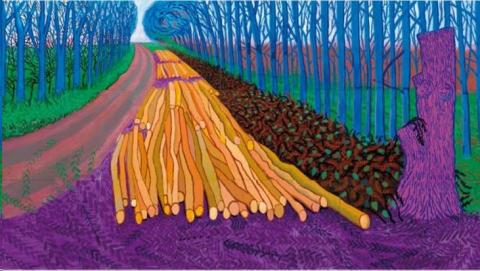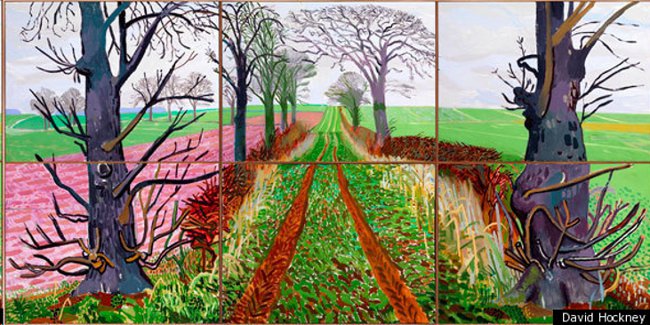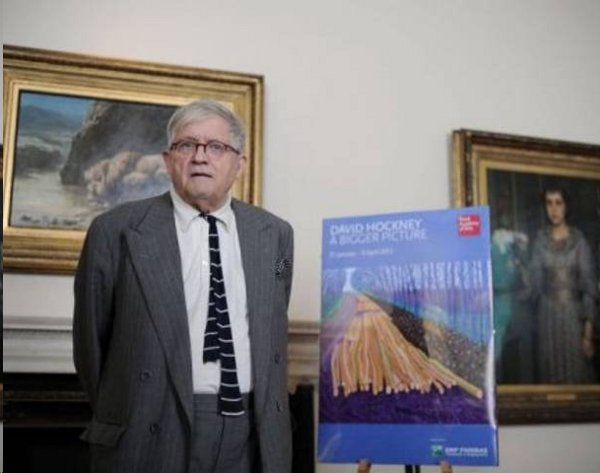David Hockney’s ‘A Bigger Picture’ Makes a Big Splash at Royal Academy of Arts

“I want to use different styles or a vocabulary of styles, as a writer uses different words. I think it is part of the technique of painting to be able to adapt yourself to different styles” – David Hockney
David Hockney has consistently experimented with various styles and mediums throughout his illustrious career, creating alternative visual languages that offer new ways of seeing. In the ‘80s, Hockney produced photocollages using hundreds of Polaroids and experimented with photocopiers and fax machines to produce art. In the ‘90s, he was using early versions of Apple software. In recent years the Apps available for the iPhone and the iPad have allowed him to push in a new direction artistically.
“A Bigger Picture,” Hockney’s sell-out exhibition, now in its final days at London’s Royal Academy of Arts, perfectly showcases his multitude of styles. The more than 150 pieces on display, most of which date from the last decade, include oil paintings, charcoal drawings, films, photomontages, watercolors and Hockney’s famed iPad drawings.
Hockney’s early landscapes dating from the ‘50s to ‘90s are displayed at the beginning of the exhibition to remind the visitor that this is not a new subject for Hockney. They also set the context for the main subject matter, the rural landscape of East Yorkshire that Hockney returned to in 2005. All the works on show were painted between 2004-2011 out in the open air in all seasons.

East Yorkshire is a far cry from the Malibu studio Hockney once called home, but after more than three decades of living in California, Hockney has returned and settled in Bridlington, a tiny seaside town in East Yorkshire. His move from West Coast America to east coast England has been a gradual one. Hockney traveled from America to East Yorkshire each Christmas and in the late ‘90s visited his elderly mother regularly. Around this time Hockney was also making trips to a terminally ill friend in a nearby village; he suggested Hockney paint Yorkshire.
It was on these trips that Hockney reacquainted himself with the landscape of his youth and became captivated with its transformation from one season to the next. This spurred Hockney to create a series of Yorkshire paintings in his studio, inspired by the memories of his trip and distant recollections from his childhood.
In June 2007, following a period of intense study of East Yorkshire's landscape, Hockney displayed his huge 50 canvas painting “Bigger Trees Near Warter” at the Royal Academy’s summer exhibition. Due to its success, the Royal Academy invited Hockney to consider a takeover of the entire Academy with a major landscape exhibition.
The result is “A Bigger Picture,” East Yorkshire viewed through California-tinted glasses. Gone are the greys and browns that characterize a typical English winter day. Hockney’s winter is full of saturated color, as is his spring, summer and autumn.
From room to room, Hockney ecstatically depicts everyday scenes of nature. He has painted the same scene repeatedly at different times of the year, the seasonal changes become the subject, with the shift in light across the fields, the trees in bloom in summer, and stark and fragile in winter, Hockney paints it all.

The beauty in this exhibition comes from paintings like “Late November Tunnel,” one of a series that depict a farm track at different times of the day and year. This painting draws the viewer in and places them on the track while the warmth of the winter sun projects outwards from the canvas into the room.
Hockney’s imagination has been left to run wild at times and his series of paintings devoted to the gentle spring blossom are quite surreal. Hockney’s hawthorn blossom loses its delicacy and becomes a monstrous exaggerated form, appearing heavy on the trees, overwhelming them with their weight.
Hockney’s art has always been concerned with representing what the eye sees, and in the case of the blossom, sometimes what it does not. This is what David Hockney asks of the viewer: to see things, not to glance momentarily, but to really see, and see afresh as if for the first time. It is as if in painting the blossom, he deliberately emphasizes it and changes its form so people might stop and notice the occurrence of this natural phenomena.
Hockney also uses scale to grab attention. “Woldgate Woods” features seven large oil paintings each consisting of six large canvases. Hockney painted these at the same fixed point at different times of the year. The long path through the painting, a motif often used in earlier works, invites a walk into the forest. The eye doesn’t know where to focus, in the foreground, or the background, left or right, the size and depth make it difficult to take it in all at once.
It is not necessarily the largest paintings that steal the show. The quiet subtlety of the watercolors beautifully capture the genteel nature of the English countryside. Although watercolors allowed Hockney to work quickly, the iPad moved things even further. In 2011 Hockney used it to design the cover of the New Yorker and has been known to send daily doodles to friends.
The iPad drawings Hockney has created in recent years have received a mixed response from critics. The Guardian’s Laura Cumming wrote, “With their felt pen squiggles and eerily empty transitions, so reminiscent of Photoshop, they appear inert and dehumanised”. While Henry Chu of The Los Angeles Times wrote “The paintings and poster-size prints from iPad drawings evoke Van Gogh, Seurat, Rousseau and even Hockney himself from his earlier, sun-drenched period”. Art is subjective after all, and the iPad Hockney argues is just a tool ( as is the brush) The spontaneity and speed with which Hockney can work with the iPad has its advantages.
Although the iPad drawings may lack the intensity of Hockney’s oil paintings, like a sketchbook, they allow the artist to immediately react to the landscape around him and record subtle changes or passing events that catch his eye.

Finding new ways to depict the landscape, shift perspectives and alert us to the finer details are a preoccupation of Hockney’s throughout this exhibition, as with his entire career. Nowhere is this better illustrated than with his multiscreen film. In the film, Hockney attached nine cameras to a grid mounted on his jeep and recorded a woodland scene as he slowly drove through it. The resulting 18-screen film is mesmerizing, the intense view of each scene the camera captured is shown across a pair of screens. Often Hockney will juxtapose footage from the same place at different times of the year, giving the viewer the chance to see seasonal depictions simultaneously.
The film also challenges the obvious way of looking, the focus on one particular frame provides a chance to look intensively and study the scene in the way Hockney has -- it’s an invitation to the viewer to see the world as he does. As Hockney explained in an interview with The Guardian, “With nine cameras your eyes watch in a way they don't with just one. You continually scan and you look much harder. And in a way it is more like drawing. There are questions of composition and infinite ways to do it."
Hockney’s restless curiosity and boundless enthusiasm for the area he now calls home is felt throughout this exhibition. It draws viewers into his world and engrosses them in the everyday, less spectacular depictions of nature that often go unnoticed. Spending the day meandering through Hockney’s luminous, vibrant and at times fantastical Yorkshire countryside might just change that.
Author Bio:
Liz Appleby is a U.K.-based contributing writer at Highbrow Magazine.
For more information, visit the Royal Academy of Arts website.
All photos: From Royal Academy of Arts






























































































































































































































































































































